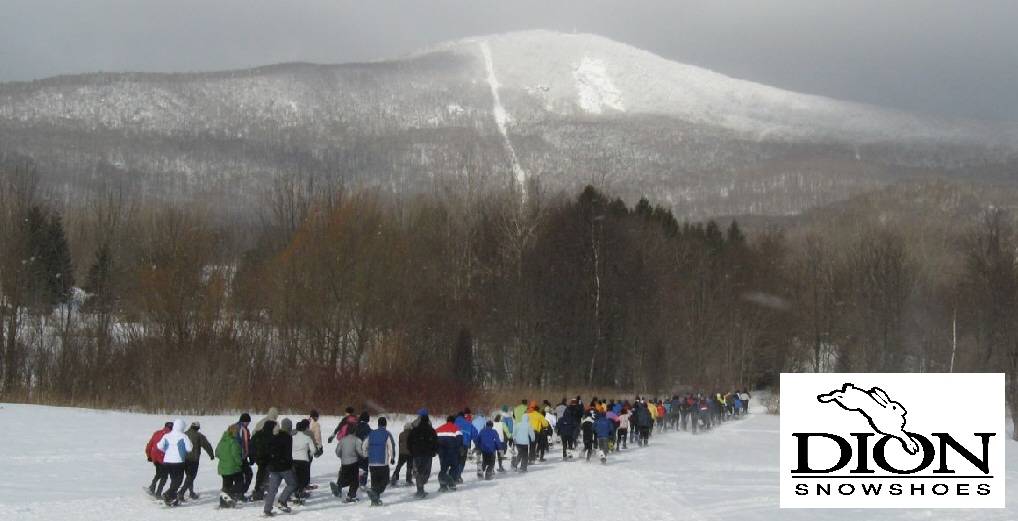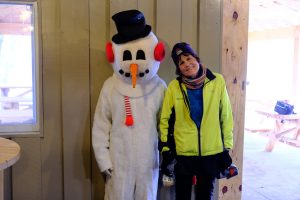by Laura Clark
This weekend I learned that I am not as tuff as I thought I was. I also learned that cavemen are much stronger than their already brawny appearance might suggest. Last year I handily survived the Caveman 6K and figured this year I should up the ante to the 15K, especially with the Nationals Half-Marathon looming ever closer on the horizon.
Make no mistake; I am not new to extreme events, having survived the Peak Snowshoe Marathon (www.peak.com) three times. Peak is nothing to take lightly. It is home to the 100 mile Winter Snowshoe Ultra not to mention the Winter Death Race. Located near Killington, the course consists of 6.5 mile loops with 1200 feet of elevation gain per loop. Nothing to sneer at, but still I found it mentally “easy” as half of each loop was an uphill slog, topped off with a steep, but totally runnable descent. I convinced myself that I was only really putting my nose to the grindstone for half of each loop. It worked.
It does not, however, work for the Stone Bridge Caveman Extreme 15K Snowshoe Race, which features seven major climbs, each punctuated by a fast downhill drop. At Peak, I was at no time tempted to utter Raven’s Nevermore. Upon stumbling down the final descent at Stone Bridge, I was more than eager to join forces with said Raven. Shortly afterward, I adjusted my attitude and waffled, “Well, if there is a foot of snow, why not?” As with childbirth, the pain is quickly forgotten in the glow of accomplishment. Just so you know, I have three children.
Stone Bridge is a traditional family-owned business that centers around the Stone Bridge Cave, the largest natural cave in the Northeast. Summer-use cabins, hiking/skiing/snowshoeing trails and guided cave excursions complete the picture. Owner Greg Beckler is proud to show off his site, telling us all, “Welcome to my backyard.” Despite the warm spell, all the main trails boasted ideal snow conditions. Still, I was a trifle worried at registration when I received my own personalized copy of the green 15K trail map. The same thing happened to me at the first Moreau Trail Race where I spent considerable time investigation alternate routes.
And sure enough, at the first intersection, I chose to head straight ahead instead of turning left as the blue bib (6K) folks were doing. I even paused, considering, but then spotted a green ribbon just ahead that I assumed justified my choice. But not for long. I soon discovered I was ahead of most of the Green Team. Lance spotted me, gave me a penalty lap and said I was good to go after that. I figure that I maybe lost a few hundred meters in the process, but as I wasn’t a winner, what did it matter? Besides, I could just see Lance calculating how much longer the finish line would have to stay open…
The course was a series of intersections, rather like the Camp Saratoga route, but with the added complexity of interweaving blue and green paths. Despite my mishap, it was extremely well marked with blue and green arrows, ribbon and spray paint. Another helpful feature was that each participant sported either a bright green or bright blue bib. So if you saw someone twisting ahead, you could take a mental snapshot of what lay in store. This happened to me a few times. At one point, Karen Provencher hailed me and I was cheered, projecting I wasn’t that far behind her. A clear example of muddled thinking at its best. Try as I might I never did figure out where she was when our paths crossed. At another point, I spotted a lady far ahead climbing a ledge and wondered where she had come from. Not anywhere nearby, I soon learned. It was a dizzying kaleidoscope of runners, all following green and blue trails from highly individual angles. Next year I intend to study the map, matching the trail names to their sections so that I will have a better idea of where I am in the grand scheme of intersecting lines. That is, if I can bear to view the section from 10-13K which more closely resembles mapped elevation lines rather than a real trail.
It seemed as if I were the only 15Ker toting water, unless there were some hidden fanny packs. I was glad I did, but with three blue coolers placed at key intersections, there was plenty of refreshment both coming and going. But with the monochromatic color scheme, it was again dizzying trying to figure out if the current cooler was a new one or an old friend viewed from a different perspective. Fortunately, there were kilometer markers to help you keep track. If you had just passed 5K and all of a sudden discovered yourself at 11K you knew something was wrong, or else perhaps you had just blanked out from the stress of climbing.
And speaking about climbs, the final ascent/descent was totally insane. With little snow cover to speak of, I found myself grateful that I had chosen not to wear my Nationals-earmarked racing Dions. But still, about halfway up I had cause to worry when I spotted a serious sign that proclaimed: “Experts only. Do not ascend after 2PM. Headlamps mandatory. Far from lodge.” There I was, exhausted, minus the required headlamp. I knew this should have been the final climb as I had passed the 13K marker. Still, if I was far from the lodge, was I embarking on a time-warped 13K?
Then, summit at last, and a glorious downhill to look forward to. Except it was more of a downhill slog if that is possible, with little snow cover and twigs weaving in and out of my Dions threatening to trip me up. More like one of those Hug a Tree trail descents where I was tempted more than once to simply remove my snowshoes for safety’s sake. The only things holding me back were that (a) I was not coordinated enough at this point to risk bending down and (b) I didn’t want to invalidate my snowshoe race standing. Greg met me at the bottom, obviously concerned, and provided me with a thoughtful snowmobile escort. I, for my part, tried not to throw up from the gas fumes.
Knowing what to expect, I know next year I can acquit myself better…or perhaps just run two 6K loops. Anything to avoid that final descent. On the plus side, I feel totally ready for the Nationals Half Marathon. How much more difficult could that be?
— Laura Clark is an avid snowshoer, trail runner, XC skier, race director, and 2017 World Snowshoe Federation Championship 70-99 Female Age Group winner. And yes, she did just ask how much more difficult the Nationals half marathon can be. Stay tuned for the answer…


